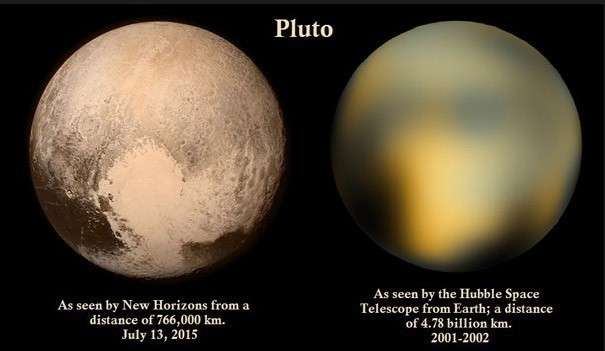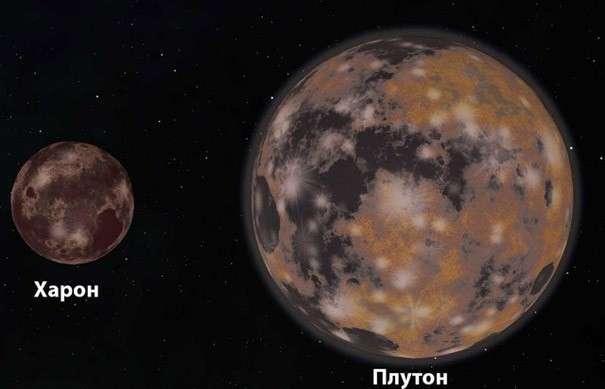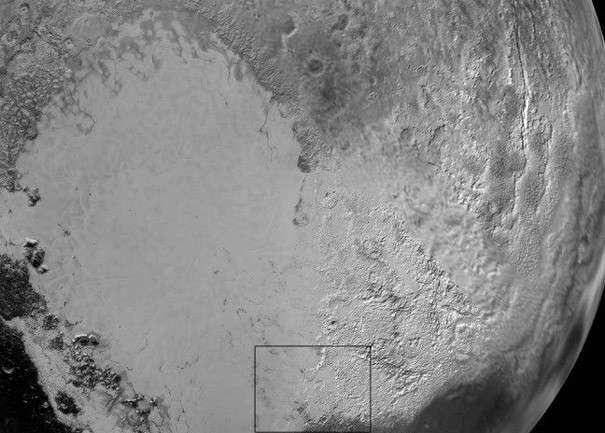More recently, any reference books and encyclopedias said that Pluto is the last, ninth planet of our star system. No one had the slightest doubt whether Pluto was a planet in the solar system.
If earlier the entire history of the development of astronomy was marked by the discovery of new celestial bodies, as a result of which the number of planets known to man increased from five to nine, then in 2006 a unique historical event occurred – there were fewer planets, as people began to believe that Pluto was no longer a planet.
Why did astronomers transfer the most distant of the planets to the category of bodies belonging to the Kuiper belt?
The main parameters of Pluto
Pluto revolves around the Sun in an orbit 5.9 billion kilometers away from it. The local year is equal to nearly 248 Earth years. Pluto has a very small diameter – 2390 km, and even the density is very low – only 1.5-2 g / cm3, in connection with which Pluto is far behind the planets in mass, for example, it is 500 times lighter than our Earth. A day on Pluto is almost equal to an Earth week.
After it was accepted that Pluto is not a planet in the structure of the solar system, something has changed. She had to shrink to the orbit of Neptune, which has now become the last planet, but the Kuiper belt has significantly expanded, which now begins immediately after Neptune. Pluto also became part of the largest (currently known) objects of the Kuiper belt.
The decision to downgrade Pluto to the category of a specially invented category of dwarf planets was not easy for scientists, around the question of whether Pluto is a planet, there were fierce disputes, which were ended by the Congress of the Astronomical Union, held in Prague in 2006.
Video about Pluto
History of the study of the planet
Pluto was only discovered in 1930. The first assumption that a transuranic object should exist was made by the American P. Lovell in 1906. But the power of the telescopes of the beginning of the last century did not allow us to notice such a distant and dim object. For the first time, Pluto was photographed back in 1915, but the image turned out to be so unintelligible that scientists simply ignored it. The laurels of the discoverer went to the American astronomer Clyde Tombaugh, who studied asteroids for a long time. He was the first to take a high-quality photograph of Pluto.
Then, for a long time, Pluto was almost not studied, all forces were thrown into the study of closer planets. Only timid plans were made to launch drones to an object located 40 times farther than the Earth from the Sun. The modest and remote Pluto did not attract the attention of scientists, which was mainly riveted to those objects on which life was at least theoretically possible, for the role of which Mars was best suited.
Finally, in 2006, NASA launched the New Horizons spacecraft towards Pluto, which on July 14 of this year finally flew past this object at a mere 12,500 kilometers.
Video about Pluto, who lost his status as a planet
The structure of Pluto
The extreme remoteness of Pluto left it little studied until recently, so knowledge about it was more based on the assumptions of scientists. The main hypothesis suggests that the surface of Pluto is made up mainly of frozen methane and water, and below them is an icy mantle, then liquid nitrogen. In the depths there is a rocky core of ice, silicates and hydrates. It is possible that the core and the mantle are separated by a liquid layer of hydrocarbons. The ice of the mantle and the surface was obtained from water raised from the depths of the planet by the decay heat of radioactive elements present in the stone fragments of the core.
Surface and atmosphere of Pluto
Tiny Pluto has a fairly large atmosphere, but it’s hardly suitable for life as we know it. It mainly consists of nitrogen, but also includes methane and carbon monoxide. It is very cool on Pluto – the average temperature there is about minus 220 degrees, and in summer (that is, every 248 years) the planet is a little closer to the Sun, the ice on its surface sublimes into gas, cooling it by another 10 degrees. At the same time, the atmosphere is noticeably warmer – “only" minus 180 degrees.
Under these conditions, the surface of the planet is wrapped in ice from frozen nitrogen, which covers both plains and mountains. At the poles of Pluto are eternal ice caps.
Pluto’s moons
In 1978, Charon was discovered – the largest satellite of Pluto, which is only half the size of itself. It is even more correct to call their systems a double dwarf planet, since its center of gravity is outside Pluto, this is also an argument in favor of why Pluto is not a planet. It is quite possible that in the near future astronomers will classify this pair as a binary system of dwarf planets. Only about 20 thousand kilometers separate the two objects. A complete revolution of steam takes 6.4 of our days, during the same time Pluto makes a revolution around itself, therefore it always “follows” Charon on one side. Eternally hanging at one point in the sky, Charon forms the phenomenon of a “tidal lock”.
Pluto has a reddish tint, while Charon has a gray tint, the latter, according to scientists, due to the presence of only water ice.
With the help of Hubble in 2005, tiny moons Nix and Hydra were discovered around Pluto, then a fourth was discovered in 2011, and a year later, a fifth satellite. All of them do not exceed 100 km in diameter and revolve around the Pluto-Charon pair.
The currently dominant theory is that there was once a glancing collision of two massive bodies, as a result of which a significant amount of material was torn out of Pluto. After some time, they formed a pair of Pluto and Charon.
What did New Horizons reveal to us?
The New Horizons mission was conceived when Pluto was still a planet, but when it launched, it was already proven why Pluto was not a planet. To date, New Horizons has opened a new round of history in the scientific study of the planets of the solar system.
Some of the discoveries just made by this mission were floating ice on the surface and atmospheric haze surprisingly dense for such a small object. Photos of Pluto showed breathtaking views of mountains made of ice, glaciers made of nitrogen. Many of the views were very reminiscent of our Arctic landscapes.
After the closest approach to Pluto in 15 minutes, the probe turned the cameras in the opposite direction and captured a view of icy plains and mountains covered with fog from 18 thousand kilometers. On the left, mountains up to 3.5 km high rise, and on the right, the Sputnik plains.
Seven hours after the rendezvous, another spectacular image was taken of the solar light streaming through Pluto’s atmosphere, revealing its distinct layered structure. The height of atmospheric haze is 130 km (more than on Earth). It has already been found that the height of one layer is 50 km, and the other 80 km above the surface.
A model for the formation of atmospheric haze has already been proposed, which is the result of a complex interaction of solar radiation with methane present in the atmosphere, when tholins (complex organic matter) are formed, which give the surface of a dwarf planet a reddish hue.
On the Sputnik Plain, scientists noticed an ice slab, which may still be moving along its surface, like terrestrial glaciers.
The latest data from the probe on the composition of Pluto showed the presence of carbon monoxide, nitrogen and methane in the ice, which in local weather conditions can be present in a solid or liquid phase.
Illumination by the Sun makes it possible to distinguish at least 12 layers in the atmosphere.
The next photo makes you feel the effect of the presence of the explorer on Pluto – here the Sun illuminates the fog, which is cut by vertical shadows from small mountains and hills. This says a lot about the local weather, which changes quite often.
Data from the latest photographs of Pluto indicate the presence of a hydrological cycle here, reminiscent of the earth. There are only more exotic soft ices, in particular, consisting of nitrogen.
The following image shows Sputnik Plain, a large bright region on the surface of a dwarf planet.
The enlarged section shows that the nitrogen ice that has collected on the hill (the right part of the image) is sliding down from the mountains to the Sputnik plain.
For scientists, the surprise was the discovery of traces of the ice cycle on Pluto. After all, the dim Sun shines much weaker here, but phase transitions of landscape components turned out to be possible on Pluto as well. In this regard, Pluto turned out to be surprisingly similar to Earth. And its surface is no simpler than the surface of Mars.







